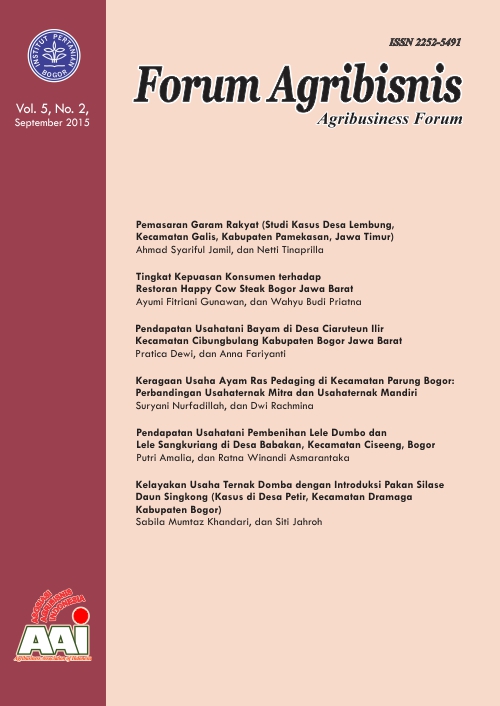PENDAPATAN USAHATANI PEMBENIHAN LELE DUMBO DAN LELE SANGKURIANG DI DESA BABAKAN, KECAMATAN CISEENG, BOGOR
Main Article Content
Abstract
Catfish is one of the nine potential leading commodities in Indonesia. The biggest demand of the fish reaches 250 tons a day in Java and this makes the fish breeding business very important. One of the catfish breeding areas is Babakan Seeng, Bogor District. There are two catfish verieties, i.e Dumbo, which is cultivated in Pokdakan Jumbo Lestari and Sangkuriang in Pokdakan kubang sejahtera. The breeding system of those varieties is different: stocking density of 10 000 juveniles per 300 m2 for Dumbo and 20 000 juveniles per 300 m2 for Sangkuriang, due to the bigger egg hatching expectation; i.e 90%. The research showed that the income of Dumbo catfish farm was Rp 7 544 531, while that of the sangkuriang catfish farm was only Rp 3 857 981. R/C ratio of Dumbo catfish farm was 1.49 and R/C ratio of Sangkuriang catfish farm was 1.16. Chi-squares analysis also proves that the difference the way aquaculture can effect farm income. This proves that Dumbo catfish farm is more profitable compared to Sangkuriang farm. Sangkuriang catfish hatchery can be more profitable when the stocking density is lessened.
Downloads
Download data is not yet available.
Article Details
How to Cite
AmaliaP., & AsmarantakaR. W. (2017). PENDAPATAN USAHATANI PEMBENIHAN LELE DUMBO DAN LELE SANGKURIANG DI DESA BABAKAN, KECAMATAN CISEENG, BOGOR. Forum Agribisnis : Agribusiness Forum, 5(2), 197-212. https://doi.org/10.29244/fagb.5.2.197-212
Section
Articles
The author submitting the manuscript must understand and agree that the copyright of the article manuscript must be submitted/transferred to the Journal Forum Agribisnis. This work is licensed under the Creative Commons Attribution-ShareAlike 4.0 (CC BY-SA) International License in which the Author and Reader can copy and redistribute the material in any media or format, and remix, modify and build material for any purpose, but they must provide appropriate credit (citing articles or content), provide a link to the license, and indicate whether there is a change. If you mix, change, or create material, you must distribute your contribution under the same license as the original.
References
Afrianto, E dan E. Liviawaty. 2005. Pakan Ikan Pembuatan, Penyim-panan, Pengujian, Pengembangan. Penerbit Kanisius. Yogyakarta.
Alawode O.O, A.O Jinad. 2014. Evaluation of Technical Efficiency of Catfish Production in Oyo State: A Case Study of Ibadan Metroplis. Journal of Emerging Trends in Educational Research and Policy Studies. 5(2): 223-231.
Beattie BR and CR Taylor. 1985. The Economics of Production. New York (USA): Wiley.
Dinas Peternakan dan Perikanan Pemerintah Kabupaten Bogor. 2012. Buku Data Perikanan Tahun 2012, Cibinong.
Debertin DL. 2002. Agricultural Production Economics. 2nd Ed. Kentucky (US): University of Kentucky
Hanafie R. 2010. Pengantar Ekonomi Pertanian. Yogyakarta (ID): CV. Andi Offset.
Hernanto F. 1996. Ilmu Usahatani. Jakarta (ID) : Penebar Swadaya
Jaja, Suryani A, Sumantadinata K. 2013. Enlargement Enterprise and Marketing of Catfish and Development Strategies at UD Sumber Rezeki Parung, West Java. Manajemen IKM. Vol 5 (1): 45-56.
[KKP] Kementerian Kelautan dan Perikanan. 2013. Volume Produksi Perikanan Indonesia [internet]. [diunduh 2014 Desember 8]. Tersedia pada http://statistik.kkp.go.id/index.php/arsip/file/37/kpda11_ok_r06_v02.pdf/
Mahyuddin, Kholish. 2008. Panduan Lengkap Agribisnis Lele. Penebar Swadaya. Jakarta
Olagunju FI, Adesiyan IO, Ezekiel AA (2007) Economic viability of catfish production in Oyo State, Nigeria. J.Human Ecol. 21(2): 121-124
Salvator D. 2005. Ekonomi Manajerial. Ichsan Setyo Budi, penerjemah; Palupi Wuriati, editor. Terjemahan dari: Managerial Economics. Edisi ke-5. Jakarta (ID): Salemba Empat.
[SNI] Standar Nasional Indonesia. 2000. Produksi Benih Ikan Lele Dumbo (Clarias gariepinus x C.fuscus) Kelas Benih Sebar Nomor 01-6484.4 –2000. Jakarta (ID) : SNI
Soekartawi. 2003. Teori Ekonomi Produksi. Jakarta [ID]: Raja Grafindo Persada.
Suratiyah K. 2011. Ilmu Usahatani. Jakarta (ID) : Penebar Swadaya
Tenaya, I M. N.2010. Metode Kuantitatif dan Kualitatif Agribisnis. Bahan Kuliah. Program Magister Manajemen Agribisnis. Laboratorium Statistika. Universitas Udayana. 2010.
Ugwumba COA. 2011. Analysis of Catfish Farming System and Its Impact on Net Farm Income in Anambra State, Nigeria. ARPN Journal of Agricultural and Biological Science. Vol 6 (2): 26-30
Alawode O.O, A.O Jinad. 2014. Evaluation of Technical Efficiency of Catfish Production in Oyo State: A Case Study of Ibadan Metroplis. Journal of Emerging Trends in Educational Research and Policy Studies. 5(2): 223-231.
Beattie BR and CR Taylor. 1985. The Economics of Production. New York (USA): Wiley.
Dinas Peternakan dan Perikanan Pemerintah Kabupaten Bogor. 2012. Buku Data Perikanan Tahun 2012, Cibinong.
Debertin DL. 2002. Agricultural Production Economics. 2nd Ed. Kentucky (US): University of Kentucky
Hanafie R. 2010. Pengantar Ekonomi Pertanian. Yogyakarta (ID): CV. Andi Offset.
Hernanto F. 1996. Ilmu Usahatani. Jakarta (ID) : Penebar Swadaya
Jaja, Suryani A, Sumantadinata K. 2013. Enlargement Enterprise and Marketing of Catfish and Development Strategies at UD Sumber Rezeki Parung, West Java. Manajemen IKM. Vol 5 (1): 45-56.
[KKP] Kementerian Kelautan dan Perikanan. 2013. Volume Produksi Perikanan Indonesia [internet]. [diunduh 2014 Desember 8]. Tersedia pada http://statistik.kkp.go.id/index.php/arsip/file/37/kpda11_ok_r06_v02.pdf/
Mahyuddin, Kholish. 2008. Panduan Lengkap Agribisnis Lele. Penebar Swadaya. Jakarta
Olagunju FI, Adesiyan IO, Ezekiel AA (2007) Economic viability of catfish production in Oyo State, Nigeria. J.Human Ecol. 21(2): 121-124
Salvator D. 2005. Ekonomi Manajerial. Ichsan Setyo Budi, penerjemah; Palupi Wuriati, editor. Terjemahan dari: Managerial Economics. Edisi ke-5. Jakarta (ID): Salemba Empat.
[SNI] Standar Nasional Indonesia. 2000. Produksi Benih Ikan Lele Dumbo (Clarias gariepinus x C.fuscus) Kelas Benih Sebar Nomor 01-6484.4 –2000. Jakarta (ID) : SNI
Soekartawi. 2003. Teori Ekonomi Produksi. Jakarta [ID]: Raja Grafindo Persada.
Suratiyah K. 2011. Ilmu Usahatani. Jakarta (ID) : Penebar Swadaya
Tenaya, I M. N.2010. Metode Kuantitatif dan Kualitatif Agribisnis. Bahan Kuliah. Program Magister Manajemen Agribisnis. Laboratorium Statistika. Universitas Udayana. 2010.
Ugwumba COA. 2011. Analysis of Catfish Farming System and Its Impact on Net Farm Income in Anambra State, Nigeria. ARPN Journal of Agricultural and Biological Science. Vol 6 (2): 26-30

